The Optical Tube
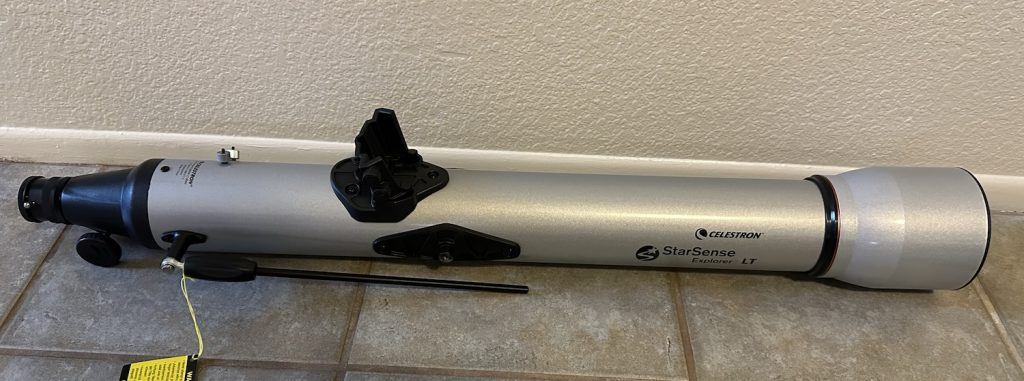
The StarSense Explorer LT 80 AZ utilizes the same optical tube found in the Celestron Inspire 80AZ and other similar 80mm refractors. Like all such refractors, I can confirm that the optics in the LT 80 AZ are quite good and will serve well for lunar, planetary, and double star observation.
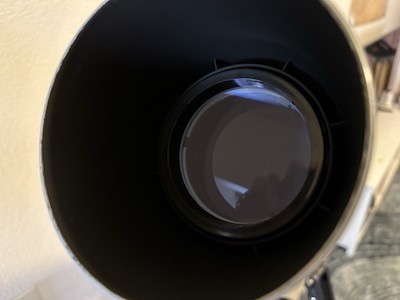
A small aperture (80mm), slow focal ratio (f/11) achromatic doublet refractor such as the LT 80AZ shows only slight purple fringing on bright targets like the Moon, planets, and naked-eye stars. This effect, known as chromatic aberration, isn’t enough to significantly hamper my views through the LT 80AZ. However, many eyepieces, such as the included 10mm eyepiece that I tested, add more chromatic aberration of their own, which I found to be a nuisance.
Refractors don’t require collimation (alignment of telescope mirrors), and I’ve always experienced that smaller refractor models like this one cool down to ambient temperatures pretty quickly, which I believe makes the LT 80 AZ attractive as a “grab n’ go” telescope for quick peeks at bright targets from home.
The focuser on the LT 80 AZ is a plastic 1.25” rack-and-pinion unit. It works fine with all but the heaviest eyepieces and diagonals, which you’re unlikely to use anyway since most such eyepieces cost more than the LT 80 AZ itself.
Accessories with StarSenes Explorer LT 80AZ
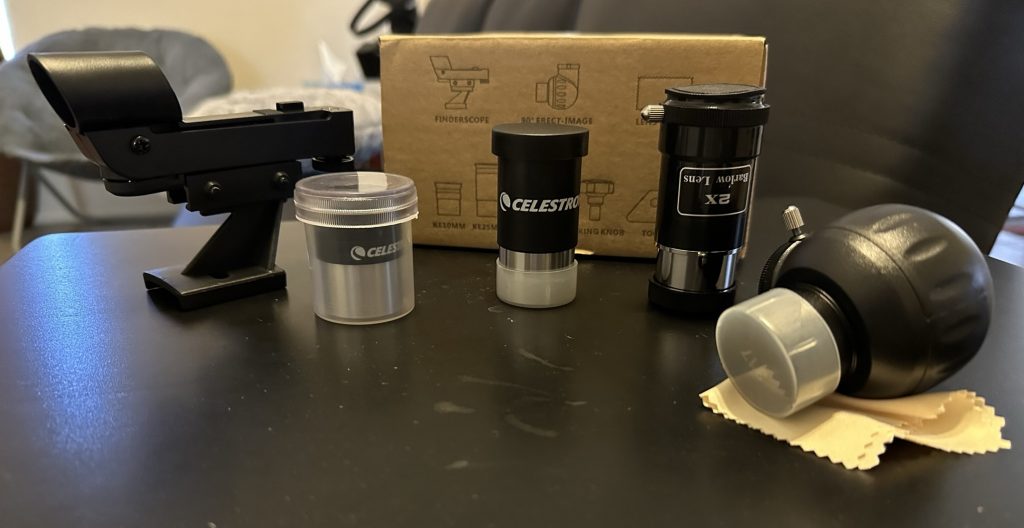
The StarSense Explorer LT 80 AZ includes two 1.25” eyepieces: a 25mm “Super” Konig providing 36x and a 10mm “Super” Konig providing 90x magnification.
Both eyepieces have plastic bodies and barrels but coated glass optics. The Konig optical design provides a fairly sharp 55-degree apparent field of view with longer eye relief than a Plossl design. The 10mm Super is easy to look through without jamming my eyeball into it, as I would have to with one of my 10mm Plossl eyepieces.
A 2x, all-plastic Barlow lens is included with the StarSense Explorer LT 80 AZ to double the included Super eyepieces’ magnifications to 72x and 180x, respectively. But the Barlow is poor quality, and 180x is too much magnification for the LT 80 AZ to realistically handle anyway. 90x is all you need or should be using. There’s really no need to go out and buy additional eyepieces; you’re essentially covered with the included pair.
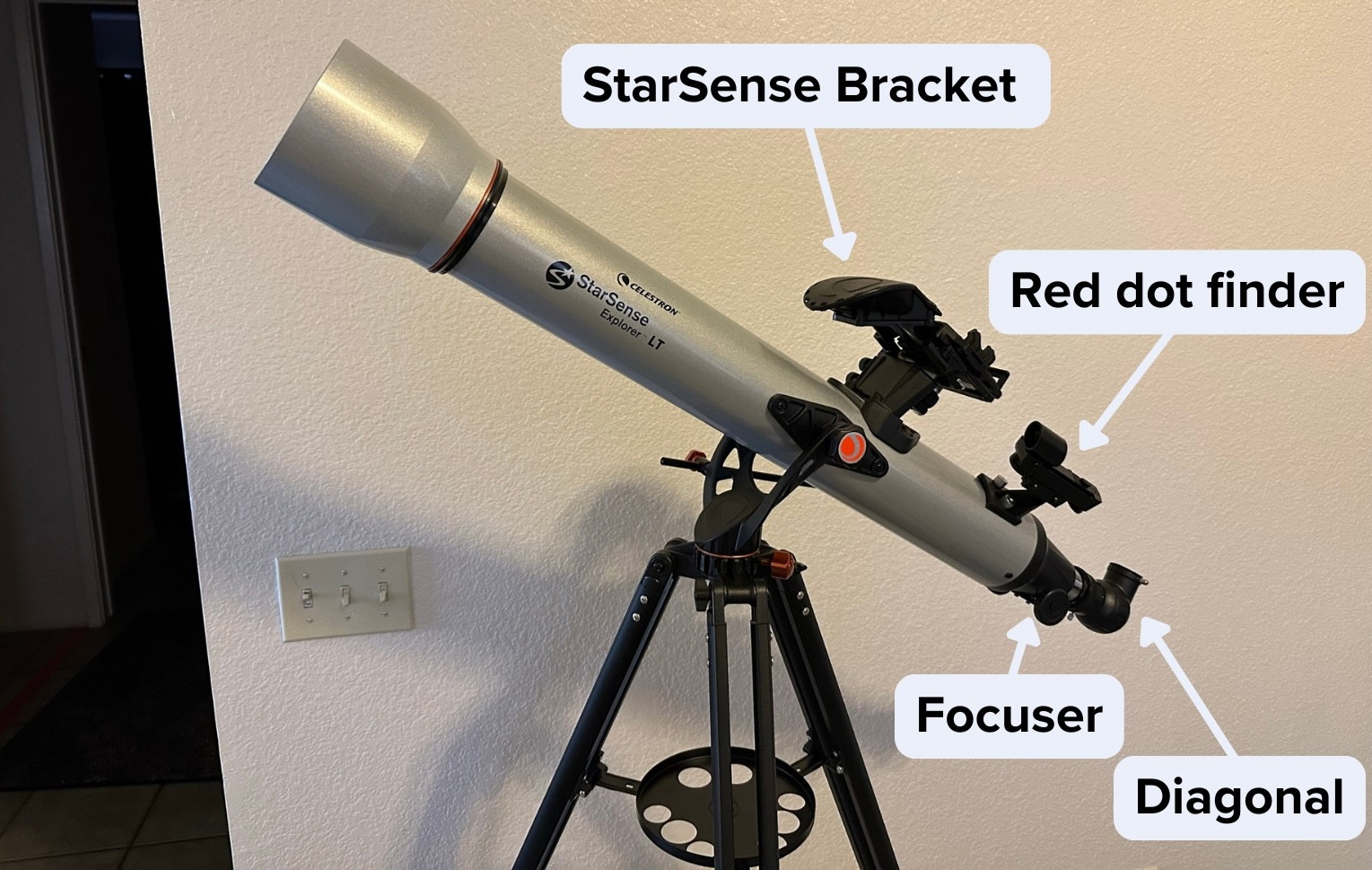
Being a refractor, the StarSense Explorer LT 80 AZ needs a star diagonal for comfortable viewing. Celestron has chosen to provide their standard 1.25” Amici-prism unit, which provides a corrected left-right view at the expense of glare and vignetting with wider-angle eyepieces than the stock 25mm. The provided diagonal also produces a bright diffraction spike on targets like planets and stars. It is mostly plastic and really a bottleneck on the telescope’s performance. I would recommend you replace it at the earliest opportunity.
As with many beginner telescopes, the StarSense Explorer LT 80 AZ comes with a red dot finder for aiming it in the sky. A red dot finder is really all you need for looking at the Moon, planets, and bright deep-sky targets.
Mount

The StarSense Explorer LT 80 AZ uses a pretty basic fork mount with a tangent arm much like that provided with what I call “cheap department store” refractors, though thankfully it turned out to be pretty stable when I used it.
However, the mount lacks any kind of slow-motion adjustments and is wobbly enough that pushing on the tube to make fine adjustments at high magnification is really annoying.
Thankfully, I couldn’t see any plastic parts in the mount.
The StarSense Explorer Technology & App
The StarSense Explorer technology takes advantage of the existing camera and gyroscopes in your smartphone to aim the LT 80 AZ around the sky without the use of additional encoders, motors, or electronics. Apart from the provided mounting bracket with an adjustable mirror, all of the StarSense Explorer technology is on the software end, inside your phone.
The StarSense Explorer app initially takes a few snapshots of the sky in the mirror with your phone’s camera to use as a reference and then estimates your position afterward using your phone’s built-in gyroscope. Obviously, the quality of your phone’s camera and gyroscopes is going to heavily dictate its accuracy, which pretty much inevitably drops off over time due to the physical shifting of the phone/bracket and the inaccuracies in gyroscope readings building up.
A good phone and alignment will achieve an accuracy of less than ¼ of a degree, or about half the width of the full moon. A bad alignment or low-quality phone would still get your target in the field of view at low power most of the time.
Should I buy a used Celestron StarSense Explorer LT 80 AZ?
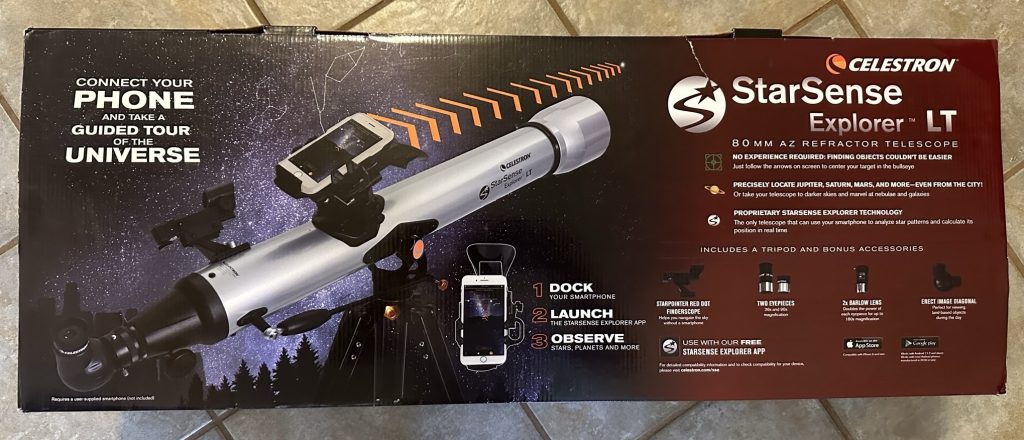
If you find a used StarSense Explorer LT 80 AZ, there’s a high chance it’s missing the StarSense Explorer bracket and/or the software code has been used up, as many of these scopes are bought solely to remove the bracket for reuse on other scopes. However, seeing as the scope doesn’t need the StarSense Explorer technology to function or to find the targets you’re likely to aim it at, you may be getting a surprisingly good deal.
Alternative Recommendations
The StarSense Explorer LT 80 AZ used to be too far from the best choice in its price range—until most of the competing tabletop Dobsonians were permanently discontinued. We have a few different alternative picks that should fit your needs and budget:
- With a little bit more money:
Those with a larger budget might want to consider a larger 130mm f/5 tabletop reflector from Sky-Watcher.
- Other tripod-mounted scope options:
If you must have a tripod-mounted telescope, the pickings are slim under $300. LT 80AZ is, in fact, a good option if you’re limited to tripod-mounted scopes for some peculiar reason. As for the alternatives, the SarBlue Mak70 with Tripod works really well, which is ranked just above the StarSense Explorer LT 80 AZ on our telescope ranking list.
Aftermarket Accessory Recommendations
The only major accessory upgrade we would recommend for the StarSense Explorer LT 80 AZ is a better star diagonal. Because the included diagonal is quite low-quality, adding a proper prism or dielectric star diagonal will significantly improve your image resolution and contrast, as well as add a few percent more brightness due to superior light throughput. The 94115-A prism diagonal sold by Celestron is all metal in construction with a multi-coated glass prism and works very well in most refractors.
A 1.25” 32mm Plossl eyepiece would provide 28x magnification with the StarSense Explorer LT 80 AZ and a slightly wider true field compared to the 25mm (about 1.9 degrees versus the Super 25mm’s 1.5 degrees), but it’s of questionable benefit and sinking a lot of money into the LT 80 AZ wouldn’t be our first choice.
What can you see with StarSense Explorer LT 80 AZ ?
The StarSense Explorer LT 80 AZ is great for viewing the Moon and planets.
- You’ll be able to see the phases of Venus and Mercury, thousands of craters and mountains on the Moon, and the rings of Saturn.
- On a clear and still night, you can spot the ice caps on Mars and maybe a few dark markings when the planet is at its closest to Earth.
- Jupiter’s colorful cloud belts and four largest moons can be seen, and you can just barely make out their shadows at high magnification when they transit in front of the giant planet. The Great Red Spot is tough to see with only 80mm of aperture, but you can just barely glimpse it on a good night.
- You’ll also be able to see the Cassini Division in Saturn’s rings, some cloud belts, and a few of its moons.
- Uranus and Neptune are featureless bluish dots, barely distinguishable from a star at all due to their tiny angular sizes, and their moons are much too faint to see.
The StarSense Explorer LT 80 AZ’s small aperture and narrow field of view make it less-than-ideal for deep-sky objects.
The telescope simply lacks the resolving power or light-gathering ability for globular clusters and galaxies (with the exception of a few bright ones with dust lanes, perhaps) to appear as anything but dim, oblique smudges.
Open star clusters are gorgeous and colorful even under suburban skies; however, bright nebulae like the Orion Nebula (M42) or Lagoon (M8) can be seen too.

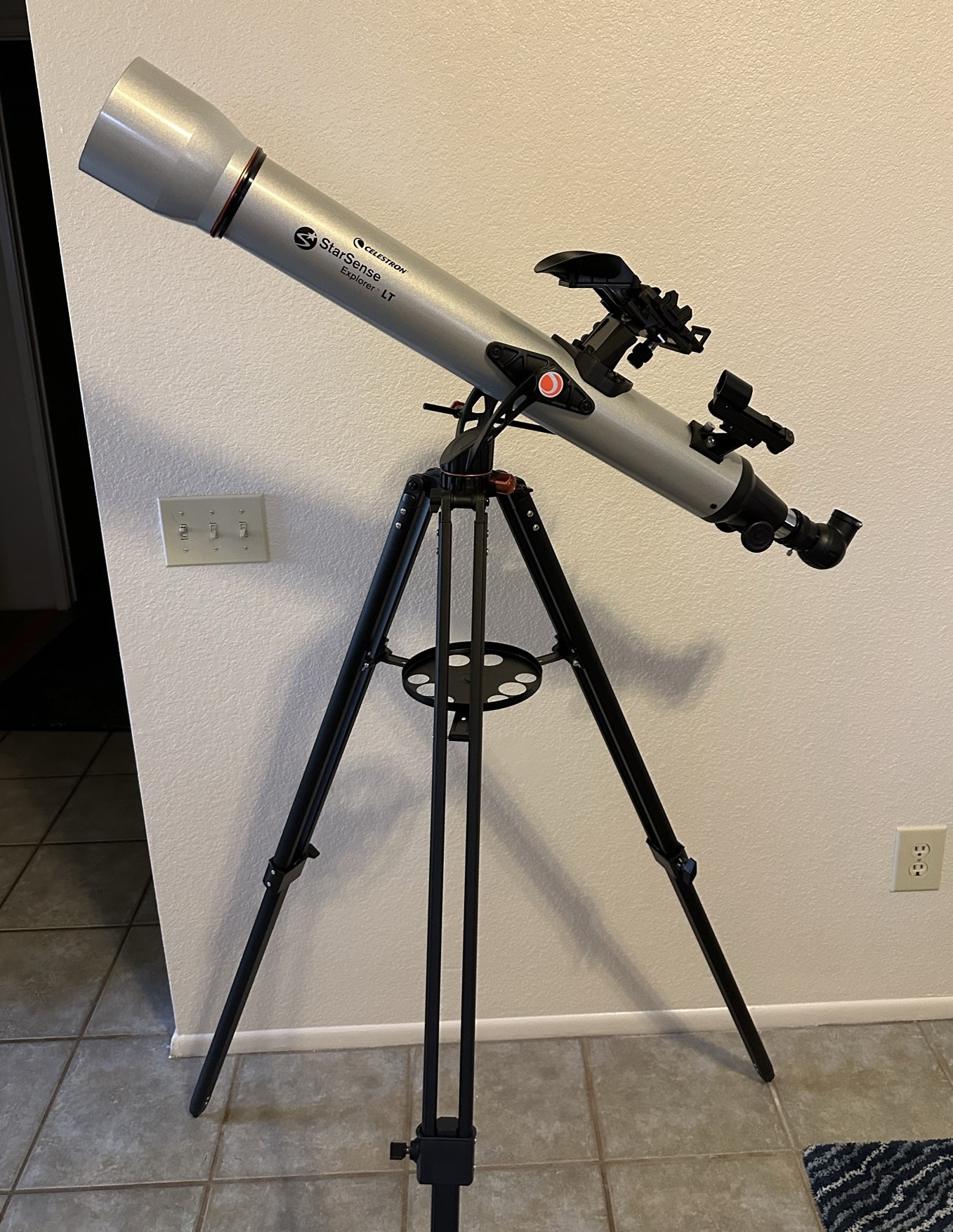
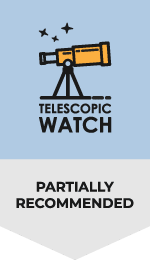

As a recent purchaser of a Starsense Explorer series telescope (8″ Dobsonian), I’m compelled to comment on the Starsense app’s incompatibility with newer smartphones. This apparent reality is inspite of information on Celestron’s list of compatible devices. My Pixel 6a doesn’t work. Online reports claim problems with Pixel 6, 6pro, 7, and iPhone 14. Users are having to resort to older phones.
My 14 works fine as do friends’ pixel 6/7 so this appears to have been resolved
Thank you for this review.
I bought this telescope to use as as a grap and go alongside my 10 inch Skywatcher dobsonian and I like it a lot.
It has great optics, no apparent chromatic abberations below 160x magnification and it’s lightweight and portable.
I can use all of my ES and TV 82 degrees eyepieces without the FOV being restricted or vigneted.
At first I had problems with the bad mount and tripod because they would make the image vibrate almost continuously. I solved this by placing a weight on the platform and hanging a heavy coat over the tube. This eliminates the vibrations. By sliding the coat I can adjust the balance of the telescope so the tube doesn’t jump up or down when I tight the orange knob after using the finder.
I removed the phone mount because I would not use it.